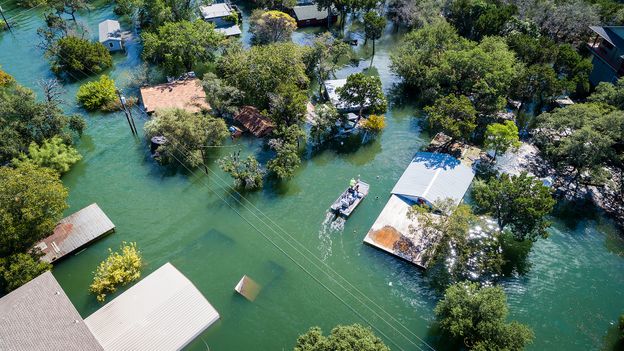
By Lucy Sherriff, Features correspondent
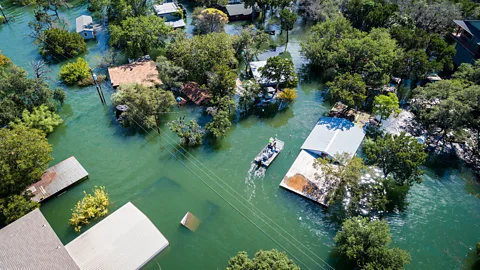 Getty Images
Getty ImagesExtreme weather events are making it hard to insure homes in certain parts of the US. What happens when insurance companies simply stop insuring?
When Frances Acuña received her flood insurance quote for the coming year, she got a shock: it would be increasing from $450 to $1,893 (£355 to £1,490). “I couldn’t pay it,” she says. “And so now I don’t have flood insurance. But I don’t feel alone as most of my neighbours don’t have flood insurance either.”
Acuña, a single mother-of-three, lives in Dove Springs in south-east Austin, Texas, an area that had, until recently, escaped the mass gentrification seen in the rest of the city. That is changing, says Acuña. The astronomical rise in flood insurance, coupled with an affordable housing crisis, is pushing many historic Latino communities out of the area.
In March 2024, Acuña, who is an organiser at Go Austin, a coalition working to improve the health of local communities, will leave the neighbourhood she has lived in for decades. “I bought this house thinking I would die in it,” she says, in tears over the decision she has been forced to make. “But I can’t afford to live here anymore.”
Acuña’s insurance went up because of a change in floodplain mapping. In 2018, the National Weather Service updated its flood models to reflect 25 years’ worth of flood data. Thousands of houses in Austin that were previously expected to flood only once in every 500 years were upgraded to a risk of one in every 100 years.
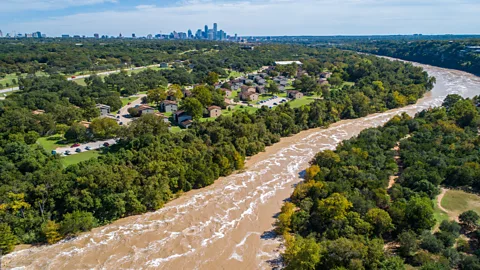 Getty Images
Getty ImagesWith the new data analysis indicating that Austin was at a higher risk of flooding than previously estimated, insurance policies for many homes skyrocketed. In the first half of 2023 alone, premiums in Texas rose by up to 16%.
Acuña didn’t feel the change until she missed a payment at the beginning of 2024 – she had other bills to pay and couldn’t spare the money. It meant her policy lapsed, and when she came to renew her policy, she was told about the dramatic increase.
An unfolding crisis
The hike in insurance costs in Austin mirrors a crisis unfolding across America – along both coasts, and through the Midwest. “If you’re not worried, you’re not paying attention,” California Senator Bill Dodd warned in 2023, following the release of a report which found Florida, California and Louisiana would see dramatic rises in home insurance premiums.
In 2022, insurance firm AllState paused selling new home and condo insurance policies in California. “Our payments to help California residents recover from accidents and disasters have increased significantly in recent years due to higher repair costs and more frequent and severe weather,” says a spokesperson for AllState. “We continue to offer coverage to most existing home insurance customers.”
In 2023, State Farm, one of the US’ biggest insurance providers, announced it too would stop selling new home insurance policies in California. “[We] made this decision due to historic increases in construction costs outpacing inflation, rapidly growing catastrophe exposure, and a challenging reinsurance market,” a statement from the company read. It was the latest insurer to pull back from the state, which has been hit by devastating wildfires and floods in recent years, and has the ever-looming threat of a major earthquake. Meanwhile, in Florida, Farmers Insurance discontinued its own-brand home insurance in the state, joining at least a dozen insurers who had already left. “This business decision was necessary to effectively manage risk exposure,” a Farmers Insurance spokesperson told the BBC.
The abandonment of these areas is part of a wider story – thanks to climate change, the US is becoming a more volatile place to live. Hurricanes, floods, storms, and fires have caused widespread mass destruction in the US over recent years. It’s also becoming more expensive, due to the costs associated with extreme weather events. A report released in 2022 analysed 120 million homes and found one in 10 properties were impacted by natural disasters. Winter storms impacted 12.7 million homes, causing $15bn (£12bn) in property damage in 2021 alone, while hurricanes caused $33bn (£26bn) in damage across 1.2 million homes.
And the future looks even worse. A recent report by First Street Foundation, a non-profit focusing on climate risk research, found 23.9 million properties in the US are at risk from damaging winds, 4.4 million properties at risk from wildfire, and a further 12 million properties have a significant risk of flooding – in addition to properties in the Federal Emergency Management Agency (Fema)’s Special Flood Hazard Areas (100-year flood zones that the government has already identified). “Private insurance companies are effectively labelling areas as uninsurable,” the report found.
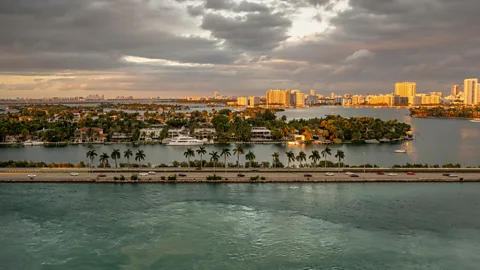 Getty Images
Getty ImagesThe home insurance market was valued at $233bn (£184bn) in 2023 It’s a business, and if business is bad, insurance companies have no obligation to stick around. Regulations in states such as California, Florida and Louisiana – some of the hardest hit when it comes to climate change impacts – have suppressed insurance prices for years. So, when disaster hits, and insurance companies have to pay out, they can’t raise prices the following year to cover their losses. As a result, the insurance industry isn’t turning as much profit as it used to, and so the financially sensible thing for them is simply to withdraw from high-risk markets, like California.
State Farm explained its decision to stop accepting new insurance policy applications in California in a press release, citing that the decision was necessary to improve the company’s finances.
“It’s necessary to take these actions now to improve the company’s financial strength,” a statement from State Farm added.
Who bears the brunt?
“A lot of folks who are the most vulnerable, and who are living in the most vulnerable areas, are the ones who tend to have the least financial means,” says Steve Bowen, chief science officer at reinsurance broker Gallagher Re. “And so how do you reconcile that?”
Communities like Acuña’s have two choices: either risk being uninsured or leave. “Our community is disappearing,” says Acuña, who doesn’t wholly blame the insurance companies but says that rising premiums have exacerbated her community’s struggles. Most community members don’t have the time to campaign for change – they’re working two or three jobs to get by, says Acuña.
So what are the alternatives?
When insurance companies pull out of states, homeowners are forced to rely on the state’s “insurance of last resort”.
In California, this is called the FAIR Plan and it’s for properties located in areas at high risk of fire that can’t otherwise get insurance. The plan covers less and charges higher premiums than conventional providers.
And yet between 2018 and 2023, the FAIR Plan’s customers have risen from 140,000 to 330,000 despite the plan only being intended for temporary use. (Californians cannot purchase a home without having adequate home insurance to satisfy banks’ home lender requirements.)
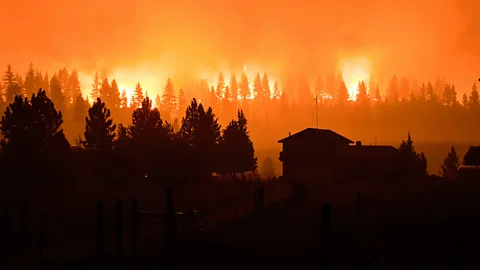 Getty Images
Getty ImagesThere is a lack of support for those who can no longer afford insurance. They simply fall through the cracks, says Acuña, whose neighbours’ houses were flooded in 2019. Their houses are still water stained. She says they have received little help from government officials.
“They just send me back and forth, blaming each other. I am a proud woman and I have been on the phone begging for help.”
Carrying on as normal
Another major concern is the real estate market continuing as usual in the face of increasing extreme weather events, meaning that home buyers have no idea when they are buying in a high-risk area.
“This unpriced flood risk could perpetuate perverse incentives for continued development in floodplains and underinvestment in hazard mitigation, further inflating the housing bubble,” the authors of one study added. First Street Foundation’s 2023 report found that policies for 39 million properties, roughly a quarter of all homes in the US, are under-priced for the climate risk to insure those properties.
“The population exposure over the next 30 years is a serious concern,” said Evelyn Shu, senior research analyst at the First Street Foundation and lead author on the report. “For decades we’ve chosen to build and develop in areas that we believed did not have significant risk, but due to the impacts of climate change, those areas are very rapidly beginning to look like areas we’ve avoided in the past.”
Mitigation and adaptation
One state-level action that could help mitigate the impacts of climate change is the implementation of flood disclosures. Organisations like the Natural Resources Defense Council have urged states to require flood disclosure polices during property sales to help buyers decide whether buying is worth the risk. Research has shown disclosure can devalue flood-prone properties and discourage development in risky areas.
Even though the number of states requiring flood disclosure policies is slowly increasing, Florida remains noticeably absent, and one-third of states still have no requirement that sellers must disclose a property’s flood risk to potential buyers.
The key is investing in mitigating the impacts of climate change in the first place, says Jesse Gourevitch, an economics researcher at the Environmental Defense Fund, who co-authored the study on unpriced climate risk. “One critical step to take is investment in disaster risk reduction,” he says. “This can occur at the individual house level and the community level – one of the best things a community can do is try to decrease their risk of loss.”
It’s an attractive prospect but in reality there are few funds available for low-income communities to adapt. Gourevitch highlights that there needs to be “much more” targeted government investment in reducing impacts on vulnerable communities. “At present there’s more funding available in adaptation and disaster risk reduction than ever before. But that’s not to say it’s enough.”
Bowen agrees. “This is a broader, more ethical question,” he says. “Where is the money going to come from? Some from the Inflation Reduction Act but that’s not nearly enough. It can’t just be [that] a select few have access to be better prepared.”
“We’re talking trillions of dollars if home and businesses are going to be retrofitted and our infrastructure is going to be modernised,” says Bowen. “And that would be a pretty tough amount of money to get through any government.”
If you liked this story, sign up for The Essential List newsletter – a handpicked selection of features, videos and can’t-miss news delivered to your inbox every Friday. Click here for the BBC’s full range of newsletters available outside of the UK.

